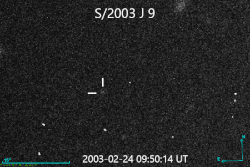S/2003 J 9
S/2003 J 9 is a retrograde irregular satellite of Jupiter. It was discovered by a team of astronomers from the University of Hawaii led by Scott S. Sheppard in 2003.[1]
 S/2003 J 9 imaged by the Canada-France-Hawaii Telescope during follow-up observations in February 2003 | |
| Discovery [1] | |
|---|---|
| Discovered by | Scott S. Sheppard David C. Jewitt Jan T. Kleyna Yanga R. Fernández |
| Discovery site | Mauna Kea Obs. |
| Discovery date | 6 February 2003 |
| Orbital characteristics [2] | |
| Epoch 17 December 2020 (JD 2459200.5) | |
| Observation arc | 15.19 yr (5,545 d) |
| 0.1615575 AU (24,168,660 km) | |
| Eccentricity | 0.1701900 |
| 2.10 yr (767.60 d) | |
| 109.89836° | |
| 0° 28m 8.381s / day | |
| Inclination | 166.33403° (to ecliptic) 13.66597° (retrograde) |
| 130.59522° | |
| 45.62861° | |
| Satellite of | Jupiter |
| Group | Carme group |
| Physical characteristics | |
Mean diameter | ≈1 km[3] |
| Albedo | 0.04 (assumed)[3] |
| 23.7[3] | |
| 16.9[2] | |
S/2003 J 9 is about 1 kilometre in diameter, and orbits Jupiter at an average distance of 0.162 AU (24,200,000 km) in 767.60 days, at an inclination of 166.3° to the ecliptic (166° to Jupiter's equator), in a retrograde direction and with an eccentricity of 0.17.
It belongs to the Carme group, made up of irregular retrograde moons orbiting Jupiter at a distance ranging between 23 and 24 Gm and at an inclination of about 165°.
This moon was once considered lost[4][5][6][7] until November 2020, when the Minor Planet Center announced the recovery of S/2003 J 9 by Scott Sheppard in observations from September 2011 to April 2018.[2]
References
- "MPEC 2003-E29 : S/2003 J 9, 2003 J 10, 2003 J 11, 2003 J 12; S/2003 J 1, 2003 J 6". Minor Planet Electronic Circular. Minor Planet Center. 7 March 2003.
- "MPEC 2020-V19 : S/2003 J 9". Minor Planet Electronic Circular. Minor Planet Center. 5 November 2020. Retrieved 5 November 2020.
- Sheppard, Scott. "Scott S. Sheppard - Jupiter Moons". Department of Terrestrial Magnetism. Carnegie Institution for Science. Retrieved 5 November 2020.
- Beatty, Kelly (4 April 2012). "Outer-Planet Moons Found — and Lost". www.skyandtelescope.com. Sky & Telescope. Retrieved 27 June 2017.
- Brozović, Marina; Jacobson, Robert A. (9 March 2017). "The Orbits of Jupiter's Irregular Satellites". The Astronomical Journal. 153 (4): 147. Bibcode:2017AJ....153..147B. doi:10.3847/1538-3881/aa5e4d.
- Jacobson, B.; Brozović, M.; Gladman, B.; Alexandersen, M.; Nicholson, P. D.; Veillet, C. (28 September 2012). "Irregular Satellites of the Outer Planets: Orbital Uncertainties and Astrometric Recoveries in 2009–2011". The Astronomical Journal. 144 (5): 132. Bibcode:2012AJ....144..132J. doi:10.1088/0004-6256/144/5/132. S2CID 123117568.
- Sheppard, Scott S. (2017). "New Moons of Jupiter Announced in 2017". home.dtm.ciw.edu. Retrieved 27 June 2017.
We likely have all of the lost moons in our new observations from 2017, but to link them back to the remaining lost 2003 objects requires more observations a year later to confirm the linkages, which will not happen until early 2018. ... There are likely a few more new moons as well in our 2017 observations, but we need to reobserve them in 2018 to determine which of the discoveries are new and which are lost 2003 moons.